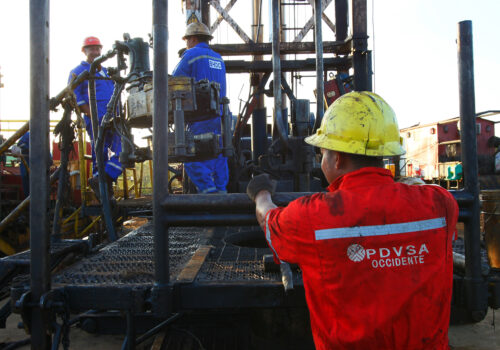Tensions between Washington and Caracas are high and could boil over. Thousands of US military personnel and about a dozen warships, including the USS Gerald Ford aircraft carrier and an amphibious ready group, are deployed around Venezuela, while the Maduro regime has launched a “massive mobilization” of military personnel and equipment.
Hopes are high that this moment could present momentum for the long-awaited democratic transition in Venezuela, and US policy should continue to press hard for it. Still, while Washington should continue to ratchet up pressure on the Maduro regime, a military intervention would hold first- and second-order risks to global energy and food markets.
Strikes limited to counternarcotics targets are unlikely to affect energy production or food markets. But any action attacking the regime itself or damaging single points of failure in the energy system, such as ports, is another matter altogether. Some proponents of military intervention in Venezuela are hopeful that any intervention would be relatively small and contained; skeptics, conversely, warn that air strikes could unleash unpredictable forces and lead to “difficult choices about whether and how to escalate.” With President Donald Trump reportedly seeking to speak directly with Venezuelan strongman Nicolás Maduro, a diplomatic solution may also emerge. We leave it to others to assess the dynamics and pathways of a coercive campaign. Still, if a small-scale intervention becomes a large one, several consequences are likely.
Even with high US domestic oil production, spare production capacity in the Gulf, and a well-stocked US Strategic Petroleum Reserve buffering crude markets, the loss of Venezuela’s heavy-sour barrels would tighten already-strained diesel markets. More dangerously, a conflict could spill over into regional oil or ammonia infrastructure—especially Trinidad and Tobago’s Point Lisas complex—likely resulting in an increase in fertilizer and food prices, which could potentially set off another bout of global inflation.
Global oil markets and Venezuela
Although it is still a significant player, Venezuela is at present not as important in oil markets as it was in pre-Hugo Chávez times. Venezuela exports stand at 800,000 barrels per day (bpd), or a little under 1 percent of total world oil consumption (although exports briefly exceeded one million bpd in September). Most export volumes head to China, directly or indirectly, while US imports have fallen below 100,000 bpd in recent months.
In the event of a US military intervention, Venezuelan production and exports would almost certainly plummet. Furthermore, US military strikes on Venezuelan territory could cause the regime to retaliate, especially if the United States attacked Venezuelan military installations or leadership offices. Venezuelan retaliation could take several forms, including sabotaging production to handicap a potential successor regime, attacking neighbors that seem to be supporting US military action, and fomenting internal political instability that makes continued operation unsafe.
Venezuela’s history shows how quickly production can drop even absent a military intervention. In 2002–2003, a Venezuelan oil workers’ strike, led by opposition to then President Hugo Chávez, reduced Venezuelan oil exports from three million barrels per day to less than 200,000 barrels per day.
At the same time, high US domestic crude and natural gas liquids (NGL) production, significant spare production capacity in Gulf states, and continued expectations for an oil market glut will put a ceiling on global oil prices—even if Venezuelan production outages occur in the short term. Additionally, the US Strategic Petroleum Reserve is well stocked.
But the longer-term picture is much more mixed. Venezuelan production would likely require several years to recover from any large-scale US military intervention. Though imperfect, comparative experiences point to the challenge of bringing postwar oil production back online. During the US invasion of Iraq, for instance, Iraqi liquids production fell to zero for several months after the invasion; annual production did not return to pre-war levels until 2011. Libya’s experience, too, suggests a disorderly political transition can severely hamper oil production. Since Libyan leader Muammar al-Qaddafi’s overthrow in 2011, Libyan liquids production has never returned to prior levels: 2024 annual production stood at 1,188 kbpd, down 32 percent from 2010 levels.
The incompetency of the Chávez and Maduro regimes leaves open the possibility that a post-Chavismo Venezuela could eventually see higher production. Indeed, the Venezuelan opposition has released a thoughtful and credible plan for bolstering oil and mining production, including by pursuing best practices. However, rebounding production will depend on several factors. For example, capital and labor will need to return to Venezuela. State-owned Petróleos de Venezuela, SA, which is debt-laden and has deferred maintenance on key pieces of field infrastructure, will need to be overhauled. And many of Venezuela’s reservoirs, which have suffered from poor production practices, will need to be restored.
Long-term Venezuelan outages would therefore likely lift oil prices, especially diesel. This is because Venezuela’s heavy-sour crude oil grades are highly suitable for producing diesel, which is a key input into virtually every industry. Recently, the International Energy Agency has warned that middle distillate markets—including diesel—are already tight. Accordingly, if Venezuela production is removed from the market, then diesel prices could shift higher, which is likely to increase global inflation.
Indeed, if US policymakers undertake military intervention in Venezuela, then they should both anticipate higher inflation via diesel markets and prepare for a post-intervention environment wherein Venezuela’s oil production takes time, and requires support, to fully rebound.
Horizontal escalation risks
A US military intervention in Venezuela might have wider regional impacts should the Maduro regime, faced with an existential threat, escalate a conflict horizontally to other countries or regions via semi-deniable proxies.
Horizontal escalation would expand the aperture of commodity-related risks. For instance, energy infrastructure in Colombia, especially pipelines, could be one such target, given links between Caracas and the ELN, a US-designated foreign terrorist organization. The ELN operates extensively in the Venezuela–Colombia borderlands, where the Caño Limón-Coveñas pipeline has been regularly attacked since it opened in 1986, including as recently as July of this year. An attack by ELN on a Colombian pipeline—either implicitly or explicitly supported by Caracas—would offer Maduro an opportunity to increase the costs of a conflict in an asymmetric or deniable manner, as even short-lived outages in Colombia would compound Venezuela’s supply losses and harm US refinery economics.
Maduro seems unlikely to approve an attack on Colombian infrastructure, for now, given his need for a diplomatic lifeline with Colombian President Gustavo Petro, a fellow leftist. But his calculus could shift after Colombia’s upcoming legislative and presidential elections in early 2026. If leftist candidate Iván Cepeda prevails, Maduro will likely still seek to preserve ties with Bogotá, but after the election he is less likely to worry that escalation might electorally empower his opponents. If a non-leftist candidate wins, conversely, Maduro may feel freer to escalate inside Colombia. Crucially, Colombia’s exports of heavy and medium sour crude oil, including medium-sour production in Caño Limón sent to the Coveñas terminal on the Caribbean for export, are highly suitable for producing middle distillates. About 40 percent of Colombian crude oil was shipped directly to the United States in 2024, and many Panama-bound shipments are transshipped to US Gulf Coast refineries. Accordingly, losses of Venezuelan and Colombian crude may significantly impact domestic fuel prices, especially for diesel.
Trinidad and Tobago’s ammonia supply chains are also vulnerable to disruption in a military conflict, especially one that expands beyond Venezuela. While accounting for only 2.5 percent of all global ammonia production, Trinidad and Tobago is responsible for 15-20 percent of global ammonia seaborne trade, and the country is the second-largest exporter to the United States, after Canada. This supply chain centers on Point Lisas, which sits on Trinidad’s west coast in the Gulf of Paria, directly facing Venezuela, about fifty kilometers away, leaving it exposed to disruption and retaliation in a prolonged conflict with the Maduro regime. Point Lisas has limited redundancy, with potential single points of failure such as the Phoenix Park Valve Station, a key hub for processing and routing gas feedstock to ammonia plants.
If Maduro sympathizers disrupt Point Lisas with cyber or kinetic attacks—including asymmetrical methods such as drones—then the effects will be felt throughout the Americas and potentially beyond. While the United States and Europe are Trinidad and Tobago’s largest ammonia partners by volumes, Mexico’s, Chile’s, and Brazil’s fertilizer markets are disproportionately exposed. Accordingly, an outage at Point Lisas would reverberate throughout the region. Mexico, too, would be impacted: It imported 250,000 tons of anhydrous ammonia from Trinidad and Tobago in 2024, while domestic ammonia production stood at only 319,000 tons. Due to deep US-Mexico agricultural ties—22.8 percent of US agricultural imports in 2024 by value hailed from Mexico—a fertilizer disruption at Point Lisas would likely send US, regional, and global food prices higher.
Carry a big stick, but think before swinging
The Maduro regime is one of the world’s worst, and it lost its legitimacy long ago. And while Maduro must step down, US policymakers should think carefully about the consequences that would accompany military force.
The United States’ strong domestic oil production and Strategic Petroleum Reserve, Venezuela’s limited role in global oil markets, and a projected state of market oversupply all lower the probability of an immediate crude-oil price spike in the event of hostilities. Yet a long road ahead for Venezuela’s oil production to rebound, as well as the possibility of spillover to other oil- or ammonia-producing countries, speaks to a wider and perhaps deeper set of inflationary risks that policymakers and market participants should take into account.
Joseph Webster is a senior fellow at the Atlantic Council’s Global Energy Center and the Indo-Pacific Security Initiative; he also edits the independent China-Russia Report.
David Goldwyn is president of Goldwyn Global Strategies, LLC (GGS), an international energy advisory consultancy, and chairman of the Atlantic Council Global Energy Center’s Energy Advisory Group.
Further reading
Wed, Sep 10, 2025
What to know about Trump’s war on drug trafficking from Venezuela
New Atlanticist By
The recent US strike on a suspected drug trafficking boat is best understood in the context of the Trump administration’s policies toward Venezuela and the wider Western Hemisphere.
Wed, Sep 10, 2025
Why the Pentagon had been reluctant to combat narco-trafficking in the Western Hemisphere
New Atlanticist By Kevin Whitaker
The recent US strike on a suspected drug-carrying vessel is a reminder that the US military had for years resisted getting more deeply involved in counternarcotics.
Tue, Nov 25, 2025
How Venezuela uses crypto to sell oil—and what the US should do about it
New Atlanticist By Maia Nikoladze
As US sanctions on Venezuela have intensified, the Maduro regime has grown increasingly interested in leveraging digital assets to facilitate oil transactions.
Image: Venezuela's President Nicolas Maduro addresses members of the armed forces, Bolivarian Militia, police, and civilians during a rally against a possible escalation of U.S. actions toward the country, at Fort Tiuna military base in Caracas, Venezuela, November 25, 2025. REUTERS/Leonardo Fernandez Viloria




